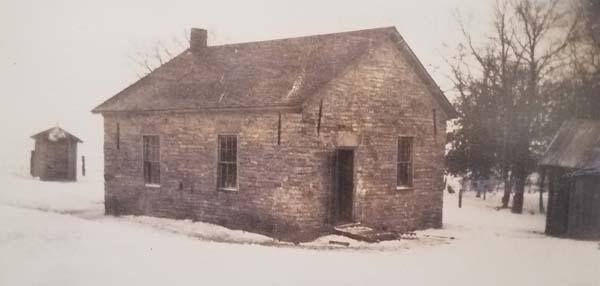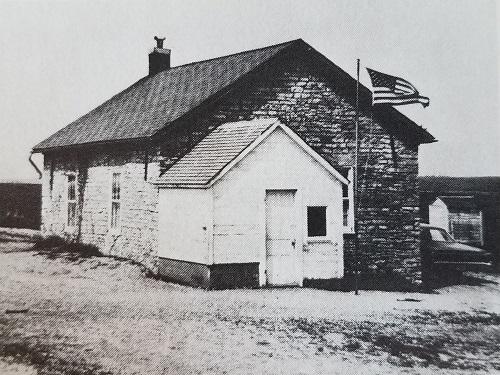updated June 15, 2019
![]()
updated June 15, 2019
Stone School, Union
Prairie No. 2
aka Rock School
Section 10, Union Prairie Twp., Allamakee co.

Stone school, No. 2, ca1932
~contributed by Aubrie Monroe - she photographed this
photo that was displayed at the Allamakee Rural All-School
Reunion, spring 2019
~*~*~
Union Prairie No. 2 Rural School, After 105 Years, Closes with Others
One hundred and five years is a long time, but when the century plus time span applies to a school in continuous use, it is really a record. When school ends this month, Union Prairie No. 2 will have rounded out a full 105 years of use as a school. The old stone building will not serve as a school again, but it is hoped it can be preserved as a reminder of its distinguished and interesting story.
When St. John The Baptist Catholic Church celebrated it’s centennial five years ago, an interesting story concerning this school came to light. Both the church and the school are built from locally cut stone, and pioneer families in the neighborhood were working hard to get both the church and the school built before that long winter of 1862 set in. The buildings were well under way, but summer field work had to be done, too, and as autumn approached it was noted that the school was going to be needed early in September. So, with one accord, the families dropped work on the church for a few weeks, finished the school, got it ready in time for classes and resumed work on the church later. Association between the church and the school has remained extremely close to this day,for all the families involved in the school district set out by the county belong even now, to the same parish church.
Still sound and snug after over 100 years of use, Union Prairie No. 2 School is pleasant inside and attractively situated on about an acre of school land. Changes have been made as the years have gone by, and repairs have kept the old structure in good condition. Union Prairie is the traditional one-room school once so common in Iowa, made with a small entryway and deep-set windows along the sides. For many years the school has had electricity and nowadays it even has a convenient telephone line.
Mrs. Eleanora Berns, the teacher, has been “Teacher” at Union Prairie for 21 years and knows all 18 of the present students well, having “had” most of their parents in classes a generation back. This years 18 students comprise grades one through six, where once this was an eight grade school. Through the years, the school has always had a full complement of students, with no “missing” grades.
Where once there was a hand-fired heating stone the school now has, and has had for some years, a dependable oil burner. At present, water is brought from a near neighbor’s well, but at one time there was a well and a bucket-and-dipper system. Water is dispensed from a water cooler nowadays, and the school has its own refrigerator stocker with milk. With electric current, the school is able to use a hot plate, and there have been hot lunches at noon for years.
Plumbing? Well, here is one place where the time-honored “little buildings out in the back” are still in use as they have been throughout the years.
Moveable desks, modern school books, and the equipment normal for a school of 1967 are all in use at Union Prairie No. 2 and the children enjoy use of a projector and other audio-visual aids needed for modern education.
Students at Union Prairie this 105th year are: Lee Colsch, Mary Rea, Geralyn Van Horn, Harold Colsch, David Johnson, Rita Dixon, Sheila Snitker, Bonita Colsch, Patrick Rea, Diane Snitker, Karen Colsch, James Dixon, Jeffrey Johnson, Michael Snitker, Carol Rea, Linda Snitker, Michael Colsch and Thomas Dixon.
Back in the days when all Iowa counties had many, many rural school districts, Allamakee had its full share of the now-vanishing small schools. In 1920, for example, there were seven town or village districts, Dorchester, Harpers Ferry, Lansing, New Albin,Postville, Village Creek and Waukon; nine township districts consisting of 62 sub-districts, and 61 rural independent school districts. On July 1, 1920, the first of many extensive changes took place when Waterville became a consolidated district and includedsix of these rural independent school districts. Further changes took place at an accelerated pace throughout the years, until, finally, July 1, 1966, the entire Allamakee county school system was accounted for in three community school districts. Mergers of Capoli No. 1 with Eastern Allamakee and of Little Paint with Allamakee Community district were the final mergers accomplishing this end.
Postville community school district, the third in this group, was formed first, July 1, 1953, taking in the nine rural independent school districts in Post township, and in an area of surrounding counties Clayton, Fayette, and Winneshiek. At that time there were three independent town districts, two consolidated and one community district in Allamakee county. The nine township districts and 49 rural independent school districts had a total of 63 teachers, and Dorchester at that time was the only remaining two-room school.
To go back, however, changes had been occurring throughout the decade following 1930. As of July 1, 1935, there were four independent town school districts: Harpers Ferry, Lansing, Postville and Waukon, and two consolidated school districts, New Albin and Waterville.There were still nine township school districts and 58 rural independent school districts, and a total of 113 rural schools in operation with 116 teachers. The schools having two teachers (in this category) were Jefferson No. 6 at Rossville, Lycurgus and Dorchester.
It was July 1, 1958 before the county situation had reached the level of having three community school districts. These were Allamakee, Eastern Allamakee, and Postville. Four rural independent school districts were left at that time: Iowa River, Waterloo Ridge, Capoli No. 1, and Little Paint.
“Reorganization” had become a state-wide movement by this time, and changes occurred more rapidly that in earlier decades, not only in Allamakee County, but all over Iowa and in nearby states. Iowa River merged with the Allamakee Community district July 1, 1960, and three years later, Waterloo Ridge came in. Thus, by 1966, the entire county was finally encompassed in three community school districts, big fleets of school busses were plying the roads every school day, andmany new school facilities had been constructed. New methods of instruction, fresh series of texts and all kinds of modern equipment had been added to school routines, but, as school people are quick to point out, three elements are still the same: the students,the teacher, and the process of education.
~source: The Democrat, May 12, 1967
~transcribed by Aubrie Monroe
~*~*~

Union Prairie No. 2, closed 1967
~photo source: The History of Allamakee County, Iowa,
1989; Page 60, courtesy of Eleanora Berns
Union Prairie No. 2 School
In 1862, the “Stone School” as it was known was built of locally cut stone by men of the area. It was located approximately at the intersection of sections 9,10,15, and 16 of Union Prairie Township, five and one half miles northwest of Waukon.
The school and St. John the Baptist Church were built the same summer. The pioneer families in the neighborhood worked hard to get both built before that long ago winter of 1862 set in. Association between the church and the school has remained extremely close for all the families involved in the school district set out by the country belong, even now, to the same parish.
Over the years there was a hand-fired heating stove, the school in later years had a dependable oil burner. At one time there was a well and bucket-dipper system. The past quarter of a century or more, water was brought from a near neighbor’s farm, dispensed from a crock water cooler. The installation of electricity meant a refrigerator to keep milk cold which was delivered weekly and a hot plate for hot meals at noon for years.
Plumbing? No, the time-honored “little buildings out back” were used throughout the years. Moveable desks, modern school books and all the equipment normal for a school of 1967 were all in use at Union Prairie No. 2 and the children enjoyed the use of a projector and other audio-visual aids needed for modern education. Union Prairie No. 2 even had a convenient telephone the last years.
Still sound and snug after 105 years of continuous use, Union Prairie No. 2 School was pleasant and comfortableinside and attractively situated on about an acre of land.
Changes have been made as the years have gone by, and repairs have kept the old structure in good condition. Reorganization had become a state wide movement by this time (July 1, 1966) and changes occurred more rapidly that in earlier decades, not only in Allamakee County, but all over Iowa and in nearby states. One hundred and five years is a long time, but when the century-plus span applies to a school in continuous use, it is really a record.
In1967 Union Prairie No. 2 was closed because of reorganization. The building was sold by the Allamakee Community School Board to Robert Rea in 1967 (sealed bid) and he sold it to James Snitker in April of 1973. It was destroyed by fire in the fall of 1976.
Teachers that taught at Union Prairie No. 2 throughout the last 80 years were: Catherine Dasher, Elizabeth O’Neill, Colleta Mellick, Veronica Ward, Cecilia Schofield, Helen Mellick, Mary Frances Foley, Mary Onsager, Margie Van Horn, Lilah Kilpatrick, Mary Hicks and Eleanora Berns. Eleanora Berns taught Union Prairie No. 2 for 21 years.
The last year, 18 students comprised grades one through six, where once this was an eight grade school. Throughout the years, the school has always had a full complement of students with no “missing” grades. Memories span the decades like the pages of a history book, recalling childhood days at Union Prairie No. 2.
~source: The History of Allamakee County, Iowa, 1989; Page 60, as submitted by Eleanora Berns
~transcribed by Aubrie Monroe
~*~*~